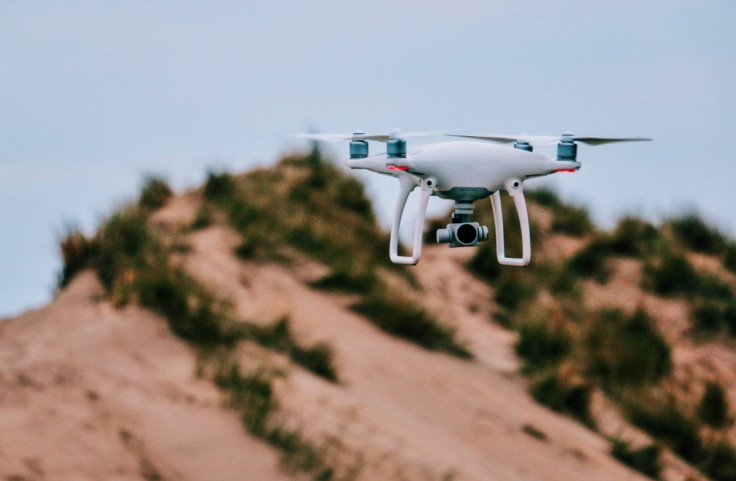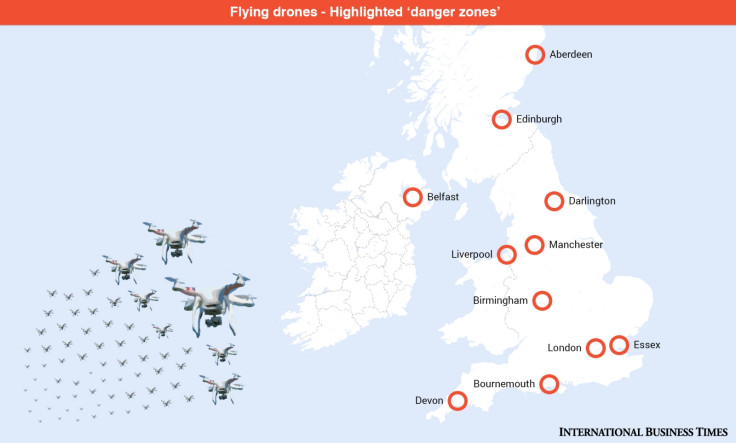Drone crashes into BA flight: Are UAV manufacturers to blame for lack of safety?

On 17 April, a British Airways flight was approaching Heathrow's Terminal 5 at around 12.30pm when an unmanned aerial vehicle (UAV) hit the front of the plane. The Airbus A320 was carrying 132 passengers and five crew. It landed safely, but airport police and the Air Accidents Investigation Branch, which investigates civil aircraft accidents, have both launched enquiries.
The incident has set off the usual spate of calls for drones to be banned outright before tragedy has the chance to strike, but the UAV industry in both the UK and the US feels that this is too strict a stance to take, and one that would impede the commercially lucrative drone industry from taking off.
IBTimes UK has spoken exclusively to the world's largest drone manufacturer DJI, US commercial drone operating system makers Skyward IO and UK drone industry body ARPAS-UK about the implications of drones potentially causing harm to civilian aircraft, and what steps, if any, should be taken.
"Banning things doesn't prevent the technology from taking hold. You can ban ready-made drones, but technology is at such a stage that you can 3D print out your own airframe, you can download software to control it, you can print out your own circuit boards to host the software. [Banning] would be infeasible. Twenty years ago that would be a solution, but today everyone can print [a drone] in their own garage," said Paul Rigby, CEO of ConsortiQ and legislation officer for the ARPAS-UK drone industry body.
"There are over 1,500 commercial operators who are operating safely and diligently in the UK, but the one person who has received no training whatsoever, operating recklessly and in contravention of the air navigation order, is the one incident that receives widespread publicity."
Geofencing should be mandatory
Instead, drone industry insiders say more pressure should be placed on consumer drone manufacturers such as DJI to implement mandatory security features. These would include geofencing, which completely prevents consumers from flying drones anywhere near airports and other restricted areas, as well as stopping them from being able to fly drones as high as they like.
There are over 1,500 commercial operators who are operating safely and diligently in the UK but the one person who has received no training whatsoever, operating recklessly and in contravention of the air navigation order, is the one incident that receives widespread publicity,
"If you're going to have safety features on the drone, it should be idiot-proof and come as default. We shouldn't be allowing people to buy a very powerful piece of equipment and let them use it with no training whatsoever, and not just anyone should be able to fly just anywhere above 400ft," stressed Rigby.
"Yes, they should push out mandatory geofencing, and it's well within their ability to do that. The burden is definitely on the manufacturers to take responsibility for the capabilities they're introducing."
His feelings are echoed by Jonathan Evans, founder and CEO of Skyward IO, a major maker of operating systems for commercial drones that is frequently consulted by the US Federal Aviation Administration (FAA) on regulations.
Consumers need geofencing, professional users don't

"Most people that are causing these high-risk situations with drones are doing it with naivety. They don't understand the rules of the road when they put the drone into the airspace. That's a social contract that you wouldn't infringe on the safety of the aircraft. No normal person would want to threaten the lives of 200 people on its final approach to Heathrow," said Evans.
"We should have geofencing for consumers that are embedded into the drones. Procedures are what keep us safe today, co-operative air space systems where all participants understand the rules of the airspace and it's co-operatively managed by pilots who understand the system, just like drivers on a road. For commercial users, you might unlock the airspace but you would need to prove the pilot has been trained, has licences, experience and is trusted to cross those lines."
DJI introduced a geofencing system called GEO in November 2015 whereby drone pilots are sent real-time information about temporary flight restrictions from the DJI Go app, as well as cautions about flying drones in restricted areas around airports, prisons and power plants. However, this system can be switched off and there is nothing to stop users from launching a drone into the sky and letting it go above 400ft, where the drone could easily hit a plane.
DJI: We don't want to restrict users
"The balance you are trying to strike is that it's a consumer product that has technological capabilities. We have a consumer product that we want everyone from a beginner to an enterprise user to use, and if you over-restrict it, hold back its capabilities, that's not a good experience for consumers," said DJI's director of communication Adam Najberg.
When that day comes, we'll have to deal with it. We want the same thing; we're looking for a happy medium. Accidents are going to happen with anything, for example bird strikes happen all the time.
"Theoretically if you switched off the modes, you could go as far as the signal would take you. If you bought a Porsche or a Ferrari, would you want it to have a limit? There are different use cases, it's difficult to balance what's right and safe in a given situation.
"[If a drone were to hit a plane and cause an accident], then when that day comes, we'll have to deal with it. We want the same thing; we're looking for a happy medium. Accidents are going to happen with anything. Bird strikes happen all the time."
Rigby, who works with the UK government to develop better licensing and registration procedures, says that the UK drone industry is happy for more restrictions that can only be unlocked with authorisation to be placed on drones.
"Registration is only good for people who are compliant - all the commercial operators ever asked for is the ability to turn off some of the safeguarding functions as long as they have proof they've attained the training. Locking down the software is for the good of the industry," he stressed.
"Everyone in the commercial industry has predicted that an incident like this would happen for a long time, and when speaking to the government we keep asking for more policing, more monitoring, more reporting of serious incidents to the Civil Aviation Authority, but not enough is being done at the moment."
© Copyright IBTimes 2025. All rights reserved.






















